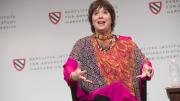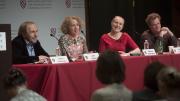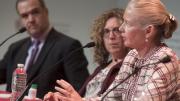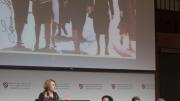As far as sex and gender are concerned, malaria seems at first to be an equal-opportunity killer; the parasite, transmitted by mosquitoes, affects women and men alike. Yet sex and gender intrude even into this seemingly isolated medical realm. As a report from the World Health Organization details, biological sex differences alter malaria outcomes—changes in the immune system, for instance, make pregnant women especially susceptible to the disease. Meanwhile, social notions of gender may have an effect on outcomes as well: men, working in fields, may be more frequently exposed to the disease, while women, caring for children and often lacking autonomy, may be less likely to seek treatment.
“Health is rarely only about health alone,” said Lizabeth Cohen, dean of the Radcliffe Institute for Advanced Study (RIAS), as she opened a two-day conference titled “Who Decides? Gender, Medicine, and the Public Health.” A series of panels explored various intersections of the social and biological realms, ranging from gendered definitions of illness and inequities in research funding to political debates over access to care. As conference organizer Janet Rich-Edwards, associate professor of epidemiology and co-director of the RIAS Academic Ventures science program, declared, “The personal is the political is the physiological.”
The conference opened with a reading by Tony Award-winning playwright and activist Eve Ensler, author of The Vagina Monologues, from her recent book, In the Body of the World: A Memoir of Cancer and Connection. Ensler, who will be artist-in-residence at the American Repertory Theater over the next several years, described how, following her childhood experience of sexual abuse, cancer and chemotherapy brought her to acknowledge and accept her own body. “When I was done with all those months of chemo, I felt like something had been burned away,” she said. Upon returning to the Democratic Republic of the Congo, where she had been working to help victims of rape and sexual assault, Ensler envisioned her most recent campaign, One Billion Rising, a global movement that uses dance to protest violence against women. Dance, she said, “is not just rage. It’s joy, it’s possibility.”
Conference participants examined at length the role of gender in shaping perceptions of health. “History, culture, and political economy come right into the physiology of the person, into the meanings of the group, and into the responses of the institutions,” said Arthur Kleinman, Rabb professor of anthropology, who is also professor of medical anthropology and professor of psychiatry. University of Western Sydney professor Jane M. Ussher traced “a medicalization of women’s misery.” “Madness is synonymous with femininity,” she said; for instance, the ancient Greeks ascribed much female pathology to the “wandering womb.” Ussher argued that even today, recognized mood disorders like premenstrual dysphoric disorder (PMDD, a severe form of premenstrual syndrome) and menopausal syndrome continue to attach blame to women’s reproductive bodies for legitimate psychological distress.
History of science lecturer Nate Greenslit described Sarafem, a drug chemically identical to the antidepressant Prozac that is marketed to women for the treatment of PMDD. An early ad showed a woman growing angry and frustrated while struggling to remove a shopping cart from its corral. Initial responses to the medication and its gendered rebranding differed; some women criticized the medicalization of the reproductive cycle, while others praised the recognition of women’s legitimate distress. As Greenslit described, “Advertising…is just the most visible form of deeper institutional fights over women’s healthcare in the U.S., including in science.”
In other medical areas as well, panelists argued, gender affects research, diagnosis, and treatment. “Disease and risk…is as much a social construct as it is a medical construct. Sometimes, public perception…will trump actual facts,” said journalist Peggy Orenstein, whose article “Our Feel-Good War on Breast Cancer” in The New York Times Magazine argued that mammography has been relatively unsuccessful at detecting more lethal forms of breast cancer, while tending toward over-diagnosis. Rates of mastectomy in response to the relatively noninvasive ductal carcinoma in situ, for instance, have soared, she observed, with women often poorly informed about how to balance medical risks with the consequences of treatment. Early screening, she said, “contributes to this larger sense that breast cancer is everywhere and happening to everyone. That, in turn, stokes women’s anxiety about the disease and their personal vulnerability.”
A sobering statistic to that effect came from C. Noel Bairey Merz, M.D. ’81, director of the Women’s Heart Center at Cedars-Sinai Medical Center in Los Angeles: “Heart disease kills 10 times more women in the U.S. than breast cancer. We spend 10 times more money on breast-cancer research than [on] heart disease research in women.” Doctors and researchers tend to recognize and diagnose only more characteristically male patterns of cardiovascular disease, she said, viewing it as a man’s problem (artery blockage due to major cholesterol buildup, for instance, is common in men but less common for women, whose cholesterol tends to distribute more evenly through the blood vessels). Even today, said Bairey Merz, “we continue to have underrepresentation of women in cardiovascular clinical trials…and this perpetuates knowledge gaps that adversely affect women.”
The last panel examined the contemporary political and media landscape. The Aspen Institute’s Health, Medicine, and Society Program director, Ruth J. Katz, M.P.H. ’80, who helped design the Affordable Care Act, highlighted how the bill advances women’s health: women no longer have to pay more than men for similar coverage, and some benefits like maternity care must now be covered by all policies. “As a nation, job well done,” said Katz. “More women now have easier and less costly access to health care they need.”
Congresswoman Louise Slaughter, Democrat of New York, highlighted advances in health equity through the years, from the Violence Against Women Act to the Genetic Information Nondiscrimination Act. Of her degrees in microbiology and public health, Slaughter declared, “I wear it like a badge of honor and stand up and yell for anything having to do with health!” Meanwhile, National Public Radio correspondent Julie Rovner had some “tough love” for press coverage of women’s health. The media helped raise awareness of the underrepresentation of women in health studies, Rovner said, but she was less complimentary about inaccurate and misleading coverage of Plan B, the emergency contraceptive, and the Affordable Care Act. “The media is, frankly, terrible at covering long-running stories,” she said. “I call it short-term media-memory syndrome.”
The conference ended with a return to its organizing question of who makes decisions. “Who decides if research funding or new drugs and new cures are directed to diseases that affect men and women?” Dean Cohen had asked at the conference’s opening. “Who decides if new health insurance policies will cover the distinctive medical needs of both sexes? Who decides if women and men will have equal access to medical treatment?”
“I think we need to get more women in the labs, in the legislature, so that women’s health doesn’t need to be tucked discreetly into landmark health legislation—it’s common sense and fair play,” said Rich-Edwards at the conference’s closing. “I think we decide.”
Eve Ensler’s presentation is available online. Videos of the other panels will be available likewise within a few weeks.
For a historical viewpoint on the intersection of sex, gender, and biology, see “Sex Science and Gender Culture.”












